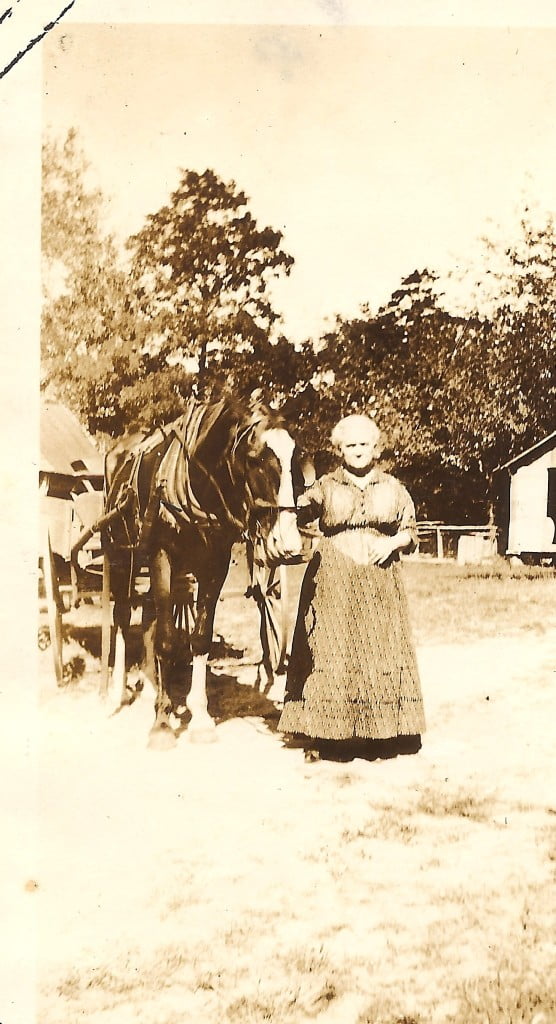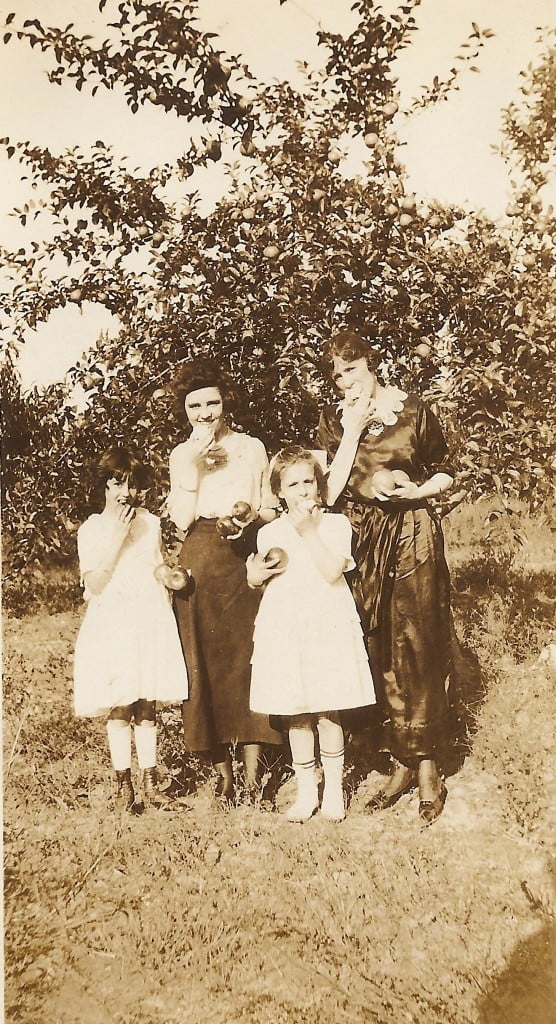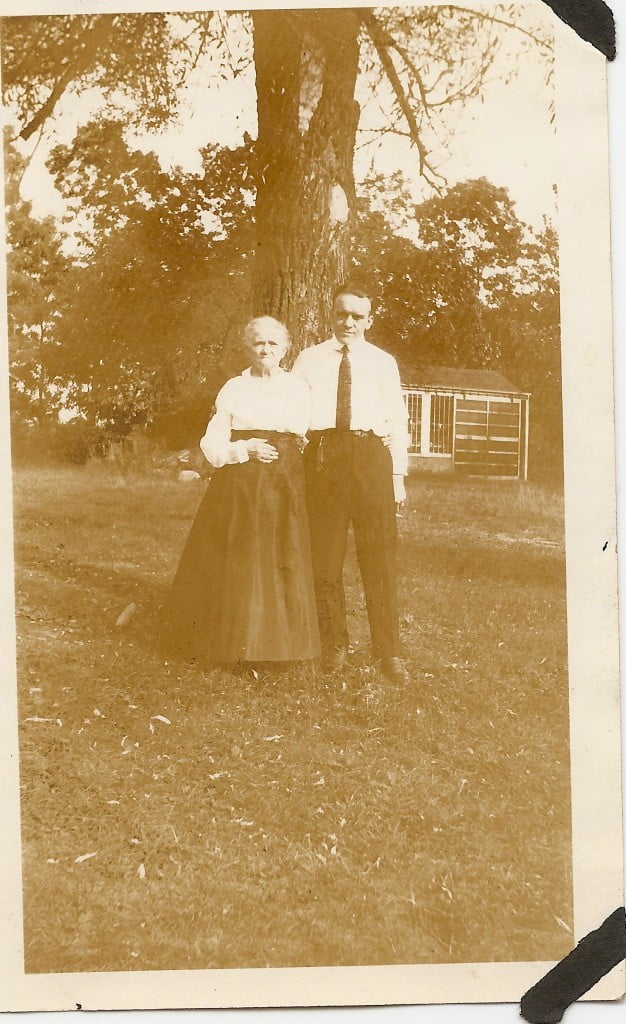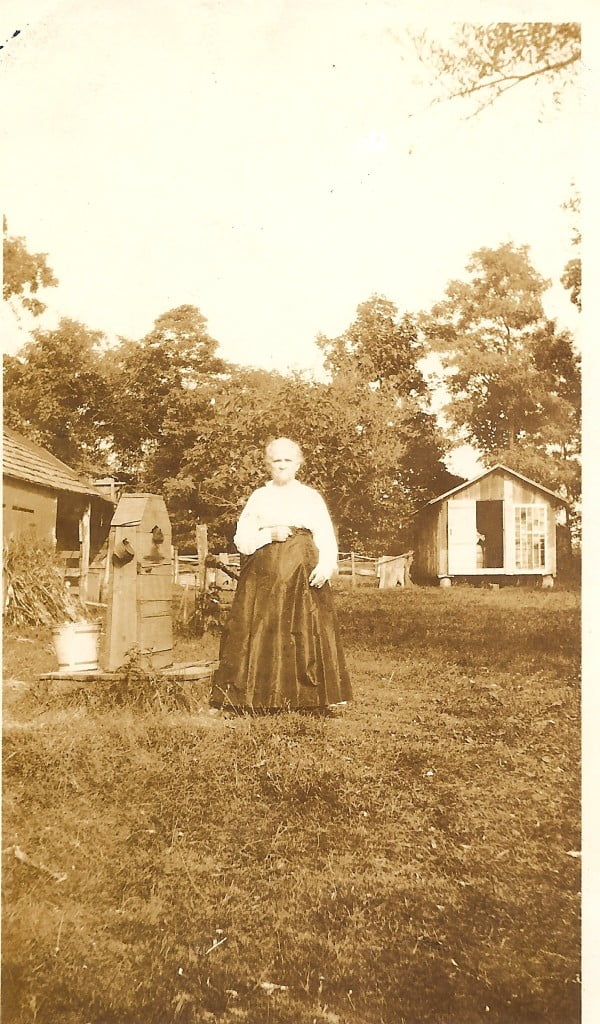Bussing Family
Mrs. Marie Bussing and her horse are photographed at the the Bussing Farm now the site of the Farmingville Hills Park.
George Bussing was a fruit farmer, growing apples and peaches as well as a diversity of produce. George and Marie Bussing were married over 50 years. They were originally from Brooklyn. They lived in Farmingville over 41 years. The Bussings had 3 daughters and 2 sons and 10 grandchildren. When Marie Bussing passed at 86, she had 18 great grandchildren and 2 great-great grandchildren.
Land for the Farmingville Hills Park was the first parcel of land in Suffolk County to be purchased under the Quarter Percent Tax which enabled sensitive land to be purchased and preserved as open space. The 102 acre parcel currently has a several marked hiking trails and is actively used by the community.
Bussing Family History
George A. (Adolf) Bussing (b. 1867, d. 1941) m. Marie Louise Whorden (b. 1870, d. 1957)
| Children of George & Marie Bussing | Grandchildren |
| Elsie Emma Bussing (b. 1889, d. 1972) Spouse. William F. Kurras (b. 1890, d. 1955) | Tillie Marie Meyer (b. 1915, d. 2013)
Emma Kuraas (b. 1916, d. unknown) George William Kuraas (b. 1919, d. 2016) William Kuraas (b. 1922, d. unknown) |
| Marie Louise Bussing (b. 1893, d. 1969) Spouse. Frederick H. Ihlo (b. 1882, d. 1970) | Louise Marie Ihlo (b. 1918, d. 2001)
Frederick H. Ihlo Jr. (b. 1920, d. unknown) George Ihlo (b. 1927, d. 1990) |
| George Adolf Bussing, Jr (b. 1895, d. 1985) Spouse. Louise Dhonau (b. 1901, d. 1961) | Louise Amelia Bussing (Vautrin) (b. 1927, d. 2000) |
| Amelia Bussing (b. 1899, d. unknown) | |
| Frederick Bussing (b. 1906, d. unknown) |
According to the United States census, George Bussing Senior emigrated from Germany to Brooklyn between 1883 and 1885. He then became a naturalized U.S. citizen on January 23, 1889. George A Bussing and Marie Whorden were married on May 8, 1888 at the ages of 19 and 16, respectively. It is unclear whether Marie Bussing was born in the United States or Germany. Like her husband, she was of German descent. In the years before moving to the Brookhaven area, the Bussings lived on Twelfth St in the 22nd ward of New York City. This was an area on the eastern edge of Brooklyn. During this time George worked as a Grocer.
Between 1889 and 1910, the Bussings had six children and one died as a child. The known children were: Elsie Emma Bussing, Marie Louise Bussing, George Adolf Bussing, Amelia Bussing, and Frederick Bussing. The name of the child that died is not known. .
The Bussing family has played a prominent role on Long Island owning property on 500 and 501 Horse Block Road. Today the land has become Farmingville Hills County Park and the Holtsville Soccer complex. The Bussing family owned this land until John Keibel bought both parcels in May 1950 for $55,000. The Patchogue Advance has mentioned both of these families extensively. The publication has recorded marriages, travels, and contributions to the community.
Regarding Travel
The Bussings were avid travelers. In January 1914, George Bussing traveled to his home country Germany, to “visit his old home and make a tour of various cities. Mr. Bussing was recorded as traveling again during the four years from 1934 to 1938, when he again visited Germany. In 1934 accompanied by his wife, but she stopped attending in 1935 due to his dislike of boat travel. Instead she would stay with family in Brooklyn. In 1940, the couple embarked on a tour of the Western United States sponsored by the American Agricultural Bureau. This was due to George Bussing being elected in 1937 as one of fifteen directors for Suffolk County Agricultural Conservation. For local travel George drove around in his Chrysler Coach which he purchased in 1928.
Farming
The Bussing family farm was a Long Island hot spot. On this farm in 1900 the Bussings were growing white peaches reported to measure one foot in circumference. On the property George Bussing had over 4,000 peach trees. The peach orchards were a prominent attraction on Long Island. On April 29, 1938 the Patchogue Advance said, “ A lovelier scene is hard to find on the island than the peach orchards…on the Bussing property.” That same year a powerful storm almost completely destroyed the orchards considered “some of the finest on this end of the Island” and caused $25,000 in damage. By 1949, the orchards were restored and Fred Bussing, George’s son, even caught a boy on August 11th stealing peaches. His father, who was subsequently arrested, drove the boy to the property for this purpose. Other extraordinary happenings occurred on the farm. For example, in 1910 Mr. Bussing had grown a pumpkin weighing 230 pounds! This was a popular local attraction for neighbors for a long time.
Community Contributions
When the Bald Hills School House was replaced by the Farmingville Holtsville school district in 1929 the Farmingville Reunion Association raised money for the School’s preservation through an auction of the land. S. E. Terry was the trustee and auctioneer for the School House. Seven people contributed to bidding. The deed eventually went to Mrs. Wendell Still of Selden who bid $1850, but George Bussing ran the auction up to $1800 before losing out to Mrs. Still. Members of the nascent Farmingville Reunion Association eventually allocated this price to preserve the school. In December 1931, George Bussing was one director of a charter to Albany separating an independent Fire Department Company with jurisdiction over the Farmingville area. Before the charter, the Holtsville-Farmingville Company covered this area. Many other community members signed including Fred Bussing. The Bussings also participated in the rejection of a proposed airport near the community, along with George Vautrin, for fears of safety and a decline in property value.
Interesting Developments on the Property
In 1897, George A. Bussing bought two parcels on Horse Block road for $1700 and established a peach orchard. The in 1900, he built two cottages on the property for employees on the farm. That same year Septer E. Terry was appointed road-master of the town responsible for de-sanding and weeding the roads from “Holtsville to Patchogue.” In July 1930, Mr. Bussing found a Spanish coin on his property dating back to King Charles IV. The coin was only partially discernible and was punctured for use as a necklace. In 1939, George Vautrin completed building a 7 room modern home on Horse Block road for Fred Bussing. George Vautrin’s son, George Vautrin Jr. eventually married Louise Bussing. They were married in the Bussing home on July 10 1949 by Rev Gerald E. Boyce and received a marriage license on July 5 1949. Other marriages mentioned include Louise Dhonau and George Bussing Jr. in 1927 and also Fred Bussing Jr. and Louise Zinn in Jan 1940. Finally, in 1940 Fred Bussing Jr. was drafted with the serial no. 3440-2154 and the next year George Bussing died. In September 1943 a pilot named Captain McAdams used the Bussing farm for an emergency crash landing of is airplane.
Keibels
In May 1950 the Bussings sold their property to John H. Keibel. Yet the next year John H. Keibel died and left half of his estate to his widow Winnie Keibel and left the other half to his sons, John and George Keibel. By 1954 there was record that Winnie Keibel had become chairman of the Farmingville Fire Department Home bureau. Similarly, John Keibel’s wife, Doris Keibel (they had married in 1949 in Farmingville’s First Baptist Church), became head of the Fire Department’s Ladies Auxiliary in 1958. The Ladies Auxiliary held events like bake sales, amateur nights, and card games in the basement of the fire hall. On Halloween of 1956 they held a dance in the fire hall basement attended by 137 community youths. Apples were donated from the Keibel farm for bobbing. Both democrat and conservative groups met in the fire hall basement. In 1962 Doris was honored for her organizing efforts with a bouquet during a fire department ceremony.
John Keibel succeeded Theodore Alexander as captain of the Holtsville Company no. 1 Fire Department in April 1957. His old job as Second Engineer was taken over by his brother John. In May 1959, in the absence of Fire Chief Dan Di Pierro, John Keibel led a 15-man team to extinguish a brush fire on Woodycrest Drive. That same year his team helped other local departments in a 3 hour fight against a conflagration in Sachem school attic that led to $100,000 in damages. He battled his first house fire on 7 Cougar Court, where a blaze in a segment of Carl Christophel’s house was contained before spreading. In 1962, as Chief he led a ten-man team to extinguish a flame from an oil truck threatening the Straub home. The year prior he and his team attended special training held by Gunman Aircraft corp, in Calverton NY. Afterwards he issued a warning to Holtsville-Farmingville residents that in the case of a crash landing of military aircraft, civilians should keep a 1500-foot distance and call their local Fire Department, who have training for that circumstance. Finally, in December 1965 John Keibel was elected fire commissioner by a margin of 254 to 98, edging out Alan McLean. Two years later tragedy struck the Keibel family, as George Keibel’s only son, George Keibel Jr., was killed in a hit-and-run while walking home on Horse Block Road. He was only 15 years old. In 1976, the Keibel family donated the land in between Horseblock Road and the Long Island expressway to the Sachem school district for community use. The land was eventually developed into the largest Soccer Complex on Long Island, comprised of 15 fields. Ever since thousands of local kids have played there.
Compiled by Stony Brook University History Interns: Gene Farmer, Samuel Vodopia, and Dylan Tack.



